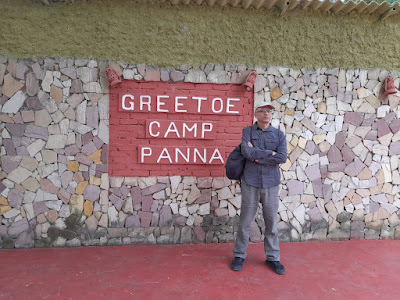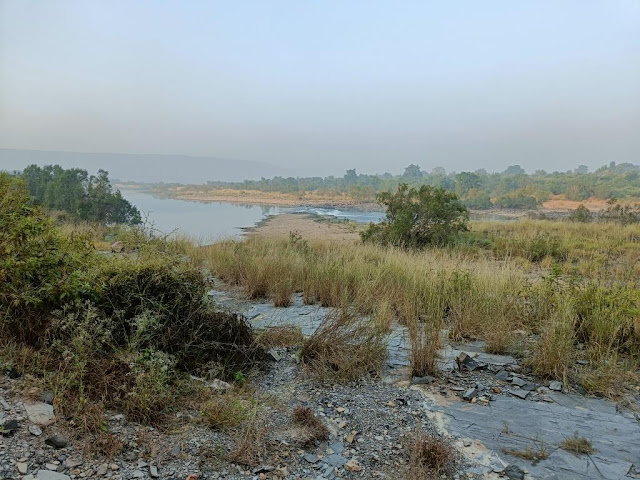 |
| Panna Tiger Reserve |
The very mention of the word Panna brings forth ideas of glittering green emeralds (Panna in Hindi) strewn around the countryside. However the only precious green object in this area of central India (Madhya Pradesh) is a large 570 Sq Km green space called Panna Tiger Reserve.
This area hosts certain fascinating geometric basalt rock formations and other geological marvels called Reneh falls, exuberantly referred to as Mini Grand Canyon! Even more fascinating is the fact that all of these things are located just 15 Km from the town of Khajuraho which is world famous for an entirely different reason!
The now largely defunct diamond mines (not emerald) of Panna exist on one edge of this protected nature reserve.
 |
This central Indian forest was historically home to a large number of tigers, and served as a game reserve for the Royal families. However, by 2009 the area became bereft of all tigers due to poaching and habitat destruction.
Then followed a reintroduction programme wherein two female and one male tiger was brought in from Kanha and Bandhavgarh. Though the male was initially reluctant to stay, the programme was eventually a success and now the park boasts of about 70 tigers in all. The tigers have a code number with a fascinating methodology. The introduced tigers are the T series (1, 2, and 3). Those born here are the P series with three digits. The first digit refers to the parent number, the second digit to the litter and the third to the actual order of birth from that litter.
As we headed by train from Delhi to Khajuraho, we happened to travel with one of the architects of the tiger reintroduction programme who was to address a conference of the newly recruited IFS probationers at the park, the next day.
 |
| Madla Gate |
A large number of women travellers alighted from the train along with us at this mofussil railway station. Since they did not seem headed to the Panna forest or the Khajuraho temples, one wondered about the purpose of this group travel.
 |
The short drive from the railway station towards the Khajuraho town took us past the civil airport which boasted of a gleaming new ATC tower building. That possibly makes it the only airport in the world closer to the old city than to the railway station!
 |
 |
We stopped for breakfast at a curiously named restaurant called “Pinch of Salt”. We really had to pinch ourselves to confirm that we were not dreaming, when the Poha arrived. It was fully loaded with ingredients hitherto fore never seen before in Poha. Must confess though that it was very tasty!
 |
| Fully loaded Poha |
Our first destination was a place called Raneh falls which was a short 30 min drive away.
 |
The knowledgeable local guides here mentioned a volcano, which actually turned out to be a rift valley created by tectonic forces. There was evidence of volcanic activity in the remote past resulting in a display of five types of rock formations namely jasper, quartz, dolomite and granite. The prominent basalt gave rise to the columnar geometric black rock formations.
 |
| Reneh Falls |
 |
 |
The waterfall disappearing 30 metres below the edge of the rift into the gorge was referred to as a mini grand canyon. The overall views were quite spectacular and the area well maintained.
It was also pointed out that if one were to visit in the monsoons, all these features would not be seen, as the flooded Ken river would inundate the entire area. It was clarified that Ken was the anglicized form of Karnavati river.
The other etymological enigma was the name of the Raneh falls itself. There was no really valid explanation forthcoming except that it was supposed to be derived from Rain!!
I presumed that there was a British origin just like Ken. The matter got further confounded when we saw a Hindi sign board mentioning it as Sneh falls!
 |
That notwithstanding, it was a nice outing.
 |
We made our way on an unpaved bumpy road towards Panna. Our lodging was approached via a kuccha road since it was located amongst vast areas of farmland. The Greetoe camp is located on the west bank of the Ken river and is a tastefully laid out premium jungle resort which even boasts of a small swimming pool. However it is located about 20 min away from the Malda Gate from where one enters the Panna forest for the morning and evening safaris.
The afternoon safari in the park took us into a beautiful natural forest which boasts of a variety of landscapes. It is primarily a mixed deciduous forest with hills in the background. There are savanna like grasslands on the plateaus at three levels. Cutting through the sanctuary is the Ken river which gives the whole area a picture postcard like appearance.
 |
| Ken or Karnavati river |
 |
 |
The treescape includes teak, kardhai, khair, tendu and the ghost tree. We were informed that the khair tree is used for producing kattha (used in paan) from the bark. The inner bark of the kardhai tree is used for medicinal purpose. The tender leaves of the tendu is rolled as bidi after being stuffed with tobacco. However no tree felling or harvesting of forest produce from these commercially important trees is permitted in the sanctuary. One village that existed inside, a few years ago has been relocated.
 |
| Leopard Male |
We were rewarded with the sighting of a leopard towards the late evening when a healthy male was making its way across the road. The bird activity was not very significanat except for the sighting of a red headed vulture.
We reported to the park gate well in time the next morning to try to make the most of the time available. The strict crowd control measures instituted by the authorities meant that there could be only 35 vehicles allowed and that too compulsorily with a local guide. However today there was an unusually large number of vehicles owing to the orientation phase of the newly recruited IFS probationers. Interestingly they seemed just like ordinary college boys and girls excitedly embarking on a jungle excursion; little did they know that they would be doing this for a living for the rest of their lives.
 |
| Sambar Deer male |
 |
| Spotted Deer |
 |
| Shikra |
 |
| Golden Jackal |
There was an abundance of wildlife in the form of spotted deer, sambar deer wild boar, blue bull etc. The 4 horned antelope or chausingha was not seen as it is very rarely sighted.
Moving along the river, our guides spotted the pug marks of a tigress pulling along a kill. (Yes pug marks can differentiate tiger from tigress!) The jeep driver suddenly got into mission mode and the game was afoot. We tracked the marks all the way to a thicket near the rivulet. Once the engine stopped we could clearly hear the rustle of the grass less than 30 yards away and sounds of the tigress and her cub feasting on the kill. The only thing to do now was to wait for them to come out and cross the road to go to the river for a drink of water. We waited for almost an hour and decided to move on for breakfast.
 |
| The Vigil |
We explored the second level of the park which took us to the vulture nesting area which is a scenic cliff face and a typical habitat for this enormous scavenger.
 |
| Vulture valley |
 |
| Long billed vulture |
On the way back we learnt that those who had the patience to wait for the tigress to feel thirsty were amply rewarded with the sight of the tigress P 141 walking towards the stream with her two cubs.
 |
| Tigress P 141 © Mandar Khadilkar |
In the jungle, the early bird catches the worm while in life, patience always pays.
Tour organizer: NatureIndia
Stay: Greetoe Camp, Panna. 06 -07 Nov 2022
Camera: Nikon Coolpix P 900 and Oneplus Nord 2
Traveler tips:
1. The train which starts from Kurukshetra will just roll in at New Delhi station on any platform that it feels like with no prior announcement.
2. The catering on the train is not great.


Very nice travelogue. Captured the essence of Panna totally
ReplyDeleteBeautiful blog Gen Joshi. Enjoyed it thoroughly specially after hearing all the details from your wife prior to reading this blog. Pic are great. Thank you for the wonderful virtual tour 👍🌺
ReplyDeleteLovely pics and description DJ.... keep them coming
ReplyDelete